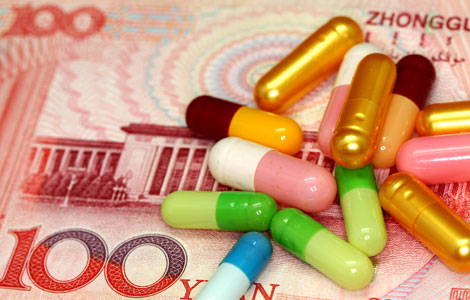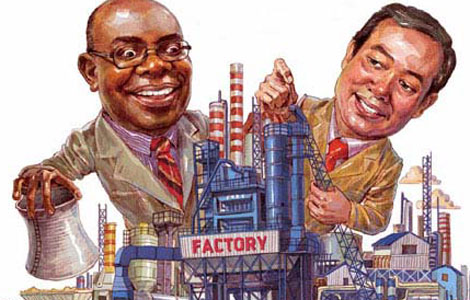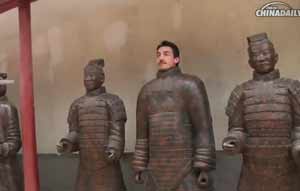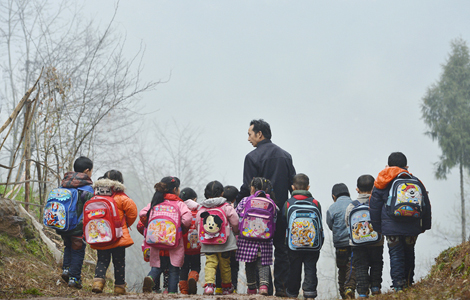China faces a rare price conundrum
Updated: 2013-07-19 09:16
By Cindy Chung and Ben Chow (China Daily)
|
|||||||||||
Why consumer prices are rising while producer prices continue to fall
China's producer price index (PPI) has been on a downward trend since March 2012.
This prolonged decline in the index that gauges product prices at factory gates is not new. There have been three such periods in the past 15 years - 1997-99, 2001-02 and 2008-09.
But it is the first time that the consumer price index (CPI), which measures prices for end-consumers, has not declined accordingly.
Indeed, the disparity between the CPI and the PPI has grown even wider.
The CPI grew 2.7 percent in June, whereas the PPI declined 2.7 percent that month.
The CPI and the PPI running in opposite directions is not a surprise, but that is has been sustained for such a long time is definitely a rarity.
Rising CPI against dropping PPI shows that price transmission is somehow distorted in China. A few factors explain why the mismatch endures and by examining the phenomenon, we may find some lingering problems in the economy.
The first reason for the disparity is that China is experiencing a massive industrial overcapacity not witnessed in recent years.
Four major industries - steel, coal, cement and chemicals - reported negative profit growth this year. Inventories of industries have also been rising, and have reached a historic peak in recent months, as reflected by the purchasing managers' index.
Overcapacity, weak demand and high stocks exert downward pressure on industrial products, forcing producers to cut prices. The situation results in the decline of the PPI.
The industrial overcapacity is a side effect of the massive stimulus and large liquidity rolled out by the government during the global financial crisis. Industries expanded very quickly, taking advantage of the government stimulus, only to find themselves stuck in a glut when the economic slowdown worsened late last year. With that glut, factories were at a disadvantage when negotiating prices with wholesalers and distributors.
By comparison, consumer demand, despite slowing down, continues to grow at a steady pace. Growth in retail sales, for example, remains at more than 10 percent, providing support to consumer prices and allowing retailers to continue increasing prices to end-consumers.
China's multi-layer retail system also contributed to the mismatch of the two price indexes.
After a product leaves the factory, it passes through a number of sellers before being delivered to the consumer. In common cases, such as the distribution of medicines, it could first be sold to a national sales agent, then a provincial agent, a city agent, a local hospital or pharmacy before finally being sold to the consumer.
During this process, each layer of distribution will charge an extra fee on the product. In this situation, even if prices at the factory gate decline, the end price could increase. In the case of medicines, the final price could be 10 times higher than the factory price.
China's sales network, on average, has at least two more layers than that of the US.
Because of this multi-layer retail system, price transmission becomes inefficient, and this is why a PPI decline is often not reflected in the CPI.
China's high logistics costs also leave little room for the CPI to decline.
In a famous case exposed by China Central Television in 2011, a truck driver, Wu Zhongyao, said he spent 8,978 yuan ($1,462, 1,121 euros) on tolls in April while making a 2,800-kilometer trip from South China's Guangdong province to Northeast China's Liaoning province. That money made up one-third of his total freight expenses, which came to about 27,500 yuan a month.
According to the China Federation of Logistics and Purchasing, 75 percent of the logistics are by road in China. The logistics cost was about 9.9 percent of a product's retail price in China last year, compared with 4.8 percent in Japan.
As logistics costs continue to rise at an annual rate of 10 percent, the CPI has to grow accordingly even though the PPI has fallen.
The last factor behind the difference in the two indicators is ever-growing property prices.
Property costs are not included in either of the two indexes, but are a significant part of business costs, and will be eventually reflected in prices of products.
The PPI mainly tracks factory-gate prices, so it is the industrial property cost that plays a role in deciding the factory goods prices.
Industrial land is usually sold or leased on a long-term contract, so its price remains relatively stable. Even if it goes up, the increase is not large.
The CPI, however, tracks consumer goods. After a product leaves the factory, distributors and retailers will pass on their costs, in which commercial property prices play a big part, to end-consumers. As commercial property prices increase at a higher rate than industrial ones, it is understandable that the CPI continues to rise despite a drop in the PPI.
The authors are analysts at Universal Consultancy in Shanghai, which specializes in research on the fast-moving consumer goods market. The views do not necessarily reflect those of China Daily.
(China Daily European Weekly 07/19/2013 page10)
Today's Top News
List of approved GM food clarified
ID checks for express deliveries in Guangdong
Govt to expand elderly care
University asks freshmen to sign suicide disclaimer
Tibet gears up for new climbing season
Media asked to promote Sino-Indian ties
Shots fired at Washington Navy Yard
Minimum growth rate set at 7%
Hot Topics
Lunar probe , China growth forecasts, Emission rules get tougher, China seen through 'colored lens', International board,
Editor's Picks

|

|

|

|

|

|





